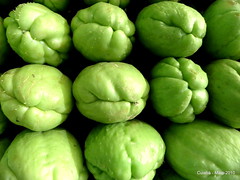Nothing to do with
Cayenne pepper, or Cayenne in
French Guyana, Cayenne is the name of an
îlet (hamlet) in the cirque of
Mafate. We
hiked there and back last weekend with friends and I thought I'd share a few photos with you.
Our trip started at Rivière des Galets, a district of
Le Port, from where you can take a taxi to the place known as Deux Bras (€7/person each way). If you don't want to pay the taxi you can walk the 10km but it's long, hot, dusty and not very interesting.
 |
| Deux-Bras taxi arrival/departure point |
Deux Bras (250m) means 'two (river) branches', and the initial part of the hike sees you walk alongside and cross the
Rivière des Galets often.
 |
| Looking at the river |
After a while you come to a fork where you can choose from two different paths to get to Cayenne - it's all very well signposted. You can also reach Aurère or Grande Place or any other location in lower Mafate using the same paths.
 |
| close-up one of the many river fords |
 |
"You take the high road and I'll take the low road" (view of Bras
d'Oussy footbridge on the higher hiking path to Cayenne; pools underneath) |
After leaving the river bed and starting to climb we could soon see Cayenne. A short distance before arriving there we came across this site (see photo below), which is where we camped the first time I ever came to Mafate in 1996!
 |
| our old camp site |
The hike as a whole was fairly easy - it only took us 2hrs and 20mins to cover the 7km from Deux Bras, walking at a leisurely pace.
 |
| Cayenne seen from the hiking path |
Cayenne is one of three îlets which together form an area known as Grande-Place, and being the îlet at the lowest altitude (541m) it is also known as Grande-Place les Bas.
 |
| Cayenne seen from the hiking path |
Overall Grande-Place conisists of ≈130 people in ≈36 families. Cayenne was home to Mafate's first school in 1923.
 |
| arrival at Cayenne |
In the 18th and 19th centuries the Atelier Colonial ('Colonial Workshops') built cayenne buildings to store the tools and equipment needed for road maintenance. Although most if not all of the buildings have since been destroyed they remain in the place name.
 |
| Cayenne's "main street" |
Cayenne's church, Notre-Dame des Lourdes, was originally built in the 1870s at Mafate-les-Eaux before being transferred to Cayenne. It later fell in ruins, but was rebuilt in 1970.
 |
| Notre-Dame des Lourdes church, Cayenne |
The bronze and iron church bell has an interesting history. Cast in 1745 in an unknown place it was taken by Mahé de La Bourdonnais in Madras (India) when the town surrendered the following year. It was sent to Réunion (then called Bourbon) in 1747, and could be found in St Denis parish church in 1755. When the cathedral was built in St Denis in 1861 the bell was transferred to Notre-Dame de Lourdes. '1745' can be seen clearly engraved on the bell, and this date makes it the oldest one in Mafate, if not in Réunion.
Our night's board and lodging was in Cayenne's only
gîte, which has four small dormitories and two double rooms.
 |
| the accommodation building of Cayenne gîte |
As is typical in Mafate we rose the next morning to a cloudless blue sky.
 |
| looking WNW from Cayenne |
 |
| looking west from Cayenne |
 |
| looking WSW from Cayenne |
 |
| looking SSW from Cayenne |
All too soon it was time to head back down to Deux-Bras.
 |
| one of the signposts along the route |
On the way back we took a slightly different route from the one we'd taken the previous day, which meant we crossed Cayenne footbridge.
 |
| Cayenne footbridge |
 |
| view from footbridge, looking north |
 |
| view from footbridge, looking south |
 |
| part of the footpath |
Further on, as we had enough time and the weather was very hot we stopped off to take a dip in some pools underneath the Bras d'Oussy footbridge.
 |
| pools underneath Bras d'Oussy footbridge |
 |
| pools underneath Bras d'Oussy footbridge |
Near Ilet les Hirondelles we came across a
tenrec, a small mammal similar to a hedgehog, which is known locally as a
tang.
 |
| this tenrec didn't want to be photographed! |
At Deux-Bras as it was Sunday afternoon some of the taxis were full to cracking; luckily not ours!
 |
| rush hour at Deux-Bras |
Just before arriving at Rivière des Galets you can currently see this interesting photo exhibition on one of the retaining walls. It consists of black and white photos of local inhabitants.
 |
| photo exhibition of Riviere des Galets inhabitants |
 |
| satellite map of our hiking route |
If you enjoyed this post you might also like:

















